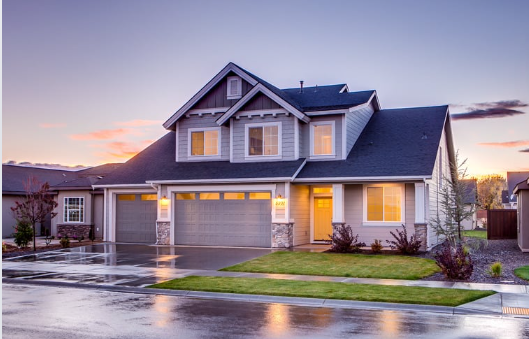How to Build a Sustainable Home in 2025: A Step-by-Step Guide
https://buymeacoffee.com/kaysogy/how-build-sustainable-home-2025-a-step-step-guide
 In 2025, building a sustainable home will no longer be just an environmentally conscious decision—it will be a practical and forward-thinking investment. With rising energy costs, increasing awareness about environmental impact, and advancements in sustainable technologies, creating an eco-friendly living space can provide long-term savings and contribute positively to the planet. Here's a step-by-step guide to building a sustainable home that aligns with modern needs and trends.
In 2025, building a sustainable home will no longer be just an environmentally conscious decision—it will be a practical and forward-thinking investment. With rising energy costs, increasing awareness about environmental impact, and advancements in sustainable technologies, creating an eco-friendly living space can provide long-term savings and contribute positively to the planet. Here's a step-by-step guide to building a sustainable home that aligns with modern needs and trends.
Step 1: Define Your Goals: Before starting, it’s essential to outline your objectives. Are you focused on reducing energy consumption, minimizing carbon footprint, or incorporating sustainable materials? This clarity will shape your approach. Whether you're a first-time homebuyer or a seasoned property investor, identifying goals helps you choose the right design, materials, and technologies.
Step 2: Choose the Right Location: The importance of location cannot be overstated in real estate and sustainability. Opt for a site that maximizes natural light and ventilation, reducing reliance on artificial energy sources. Incorporate neighborhood guides to identify areas that support sustainable living, such as proximity to public transportation and eco-friendly infrastructure.
Step 3: Incorporate Energy-Efficient Design: A sustainable home starts with a well-thought-out design. Focus on passive solar design principles:
Orientation: Position the house to maximize sunlight during winter and minimize heat gain during summer.
Insulation: Use high-quality insulation to reduce energy loss.
Windows: Install energy-efficient windows that let in natural light while maintaining temperature control.
Step 4: Use Sustainable Materials: Select eco-friendly, durable, and recyclable materials. Some popular options include:
Bamboo flooring for its renewable nature.
Recycled steel for framing, which reduces waste.
Low-VOC paints to improve indoor air quality.
Step 5: Integrate Smart Home Technology: Smart home technology is essential for monitoring and optimizing energy use. Devices like programmable thermostats, energy-efficient lighting systems, and smart appliances allow you to control consumption remotely. These tools reduce your energy bills and contribute to sustainable living.
Step 6: Incorporate Renewable Energy Sources: Install renewable energy systems like solar panels or wind turbines to generate clean energy. Advances in real estate mobile apps and digital property management now allow homeowners to monitor their energy generation and usage in real time, ensuring maximum efficiency.
Step 7: Focus on Water Efficiency: Water efficiency is a crucial aspect of sustainability. Incorporate features like:
Low-flow fixtures for faucets, showers, and toilets.
Rainwater harvesting systems for irrigation.
Greywater recycling systems to reuse wastewater safely.
Step 8: Adopt Sustainable Landscaping: Outdoor spaces play a significant role in a home’s sustainability. Use native plants, which require less water and maintenance, and consider xeriscaping to further reduce water use. Sustainable landscaping not only enhances your home’s aesthetics but also supports the local ecosystem.
Step 9: Prioritize Energy Storage and Backup Systems: Incorporate energy storage systems like home batteries to store surplus renewable energy. These systems ensure your home remains powered during outages or peak energy demand periods, making your sustainable home more resilient.
Step 10: Stay Informed About Sustainable Real Estate Trends: The real estate market is rapidly evolving, with new sustainable innovations emerging every year. Stay updated on trends such as cloud-based real estate solutions and real estate automation, which streamline processes and enhance the efficiency of sustainable homeownership.
Benefits of Building a Sustainable Home in 2025
Cost Savings: Energy-efficient homes reduce utility bills significantly.
Increased Property Value: Sustainable homes attract environmentally conscious buyers.
Environmental Impact: Lower carbon emissions contribute to a healthier planet.
Improved Quality of Life: Sustainable homes offer better air quality and a comfortable living environment.
Conclusion: Building a sustainable home in 2025 is more than just a lifestyle choice—it’s a smart investment for the future. By incorporating energy-efficient designs, renewable energy sources, and sustainable materials, you can create a home that minimizes environmental impact while maximizing comfort and cost savings. Leveraging modern technologies like smart home systems and real estate mobile apps makes the journey even more efficient and rewarding. Sustainable homes not only benefit the planet but also appeal to a growing segment of eco-conscious buyers, increasing their value in the real estate market. Whether you’re a first-time homebuyer or an experienced investor, embracing sustainability today ensures that your home remains relevant, efficient, and valuable for years to come. Start building a sustainable future now—it’s a decision you’ll never regret.
Comments
Post a Comment